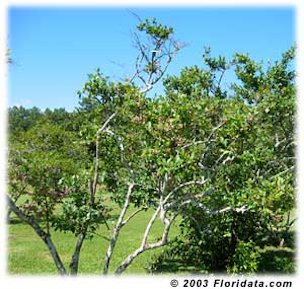From Floridata
by
Steve Christman
Vaccinium ashei
Common
Name: rabbiteye blueberry
Botanical
Family: Ericaceae, the heath Family
Description
Without
pruning, most varieties of rabbiteye blueberries are rather open,
spreading shrubs that grow up to 12 ft (3.7 m) tall. Shoots often
sprout from the roots producing new bushes. Its deciduous leaves, often
whitish or bluish underneath, turn orange and red in fall. Little pink
bell-like flowers appear in early spring with the new leaves and
sometimes get caught by late frosts. The powdery blue berries that
follow are a delight to the eye and palate and are relished by many
kinds of birds. There are many cultivars of rabbiteyes available to the
home gardener. Some commonly found at home and garden centers include
'Climax', 'Bluebelle', 'Tifblue', 'Bonita', 'Briteblue', 'Woodward',
'Southland', and 'Premier'.

It's
mid-June in Georgia and the rabbiteye blueberries are just beginning to
ripen. The unripe fruit is said to look like a white rabbit's eye -
yeah, it kinda does...
Location
Vaccinium ashei
is native to the southeastern U.S. where they occur in mixed woods, on
high banks along streams or rivers, and in pine flatwoods communities.
They are cultivated commercially from Virginia and Tennessee, west to
Arkansas and Texas, and south to central Florida. The related highbush
blueberries (V. corymbosum) are grown farther north.
Culture
Rabbiteye
blueberries are among the easiest fruits to grow IF you have the right
kind of soil. They will not tolerate clay or water-logged soils, and
like azaleas, they must have a low pH (4.2 to 5.5). When planting,
space them 4-5 ft (1.2-1.5 m) apart in full sun to partial shade. Once
established, they usually won't need to be irrigated. They cannot
tolerate most well water, because of the high pH. The roots remain
close to the soil's surface and are damaged by even light cultivation.
To control weeds and conserve soil moisture, mulch heavily with pine
straw. Use only acid type fertilizer (such as used for azalea and
camellias) at low rates and keep it away from the base of the stems.
Blueberries are easily killed by excessive fertilizer.
Light: Sun, but can tolerate considerable shade.
Moisture: They are partial to sandy, acid soils and will tolerate brief flooding as well as drought.
Hardiness: USDA Zones 7 - 9.
Propagation: Division of clumps.
Usage
Often
overlooked for home landscaping, Rabbiteyes are good no-maintenance
plants. They can also be pruned to make wildlife attracting hedges. If
azaleas or native blueberries are growing on a site, you can be sure
this shrub will do well. Rabbiteye cultivars are self-unfruitful -- you
must have 2 or more planted together to get fruit. Plant as many
different cultivars as you can to extend the harvest season. This will
also give you the opportunity to decide which ones are best for you.
Bees are the most common pollinators, especially bumblebees. Rabbiteyes
have few pest or disease problems and usually do not require spraying.
You will have to cover the bushes with netting to protect your harvest
from mockingbirds and their kin.

Rabbiteye blueberries grow as tall open shrubs which makes picking the fruit a pleasure - no stooping or sore backs!
Features
Rabbiteye
blueberries were named for their pinkish immature fruits which suggest
an albino rabbit's eye. They have soft, blue-green leaves in the
summer, followed by orange and crimson foliage in the fall. The
southeastern United States is home to many other members of the genus Vaccinium including deerberry (V. stamineum) which are also tasty to wildlife and humans. The sparkleberry (V. arboreum),
also called the farkleberry (great name!), grows to tree size and
although the fruit is bitter it is devoured by birds and other
wildlife.
 |  | | Rabbiteye blueberries | Unripe Rabbiteye blueberries |
|
|
Bibliography
Christman,
Steve. "Vaccinium ashei." Floridata, no. 252, Published 10 Jan. 1997, Updated 4 July 2003, 15 Aug. 2003, 14 Feb. 2016, floridata.com/plant/252.
Accessed 20 June 2024.
Published 20 June 2024 LR
|



